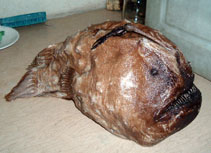| Family: |
Himantolophidae (Footballfishes) |
| Max. size: |
40 cm TL (male/unsexed) |
| Environment: |
bathypelagic; marine; depth range 338 - 1360 m |
| Distribution: |
Circumglobal in the southern hemisphere except eastern Pacific (Ref. 7300). Range extended to the Falkland Is. (Ref. 80772) and probably a first record in the Philippines (Ref. 95664). |
| Diagnosis: |
Dorsal soft rays (total): 5-5; Anal soft rays: 4-4. This species is distinguished in having the illicium with a bulbous distal light organ, originating from behind the tip of the snout; external second cephalic ray absent; esca without bony denticles; posterior appendage present, bifurcated at the base and each primary branch had a side branch near the base; distal appendage absent (Ref. 80772). Metamorphosed females characterized further by having a series of 2-7 filaments emerging from the anterior margin of the 2 primary branches of paired posterior escal appendage; posterolateral appendages simple or bifurcated at tip, longest is less than 10% SL in specimens less than 10 cm; presence of small dermal spinules on stem of illicium, escal bulb and escal appendages in specimens greater than 3 cm; low and indistinct papillae of snout and chin; skin devoid of white patches; caudal fin rays white or faintly pigmented in specimens less than 10 cm. Adult males with 11-13 olfactory lamellae; diameter of posterior nostril 5.7-6.7% SL, length of snout 17-18% SL; presence of about 20-25 upper denticular teeth and 22-32 lower denticular teeth (Ref. 86949). |
| Biology: |
Mesopelagic species (Ref. 7300). |
| IUCN Red List Status: |
Least Concern (LC); Date assessed: 11 October 2018 Ref. (130435)
|
| Threat to humans: |
harmless |
Source and more info: www.fishbase.org. For personal, classroom, and other internal use only. Not for publication.

